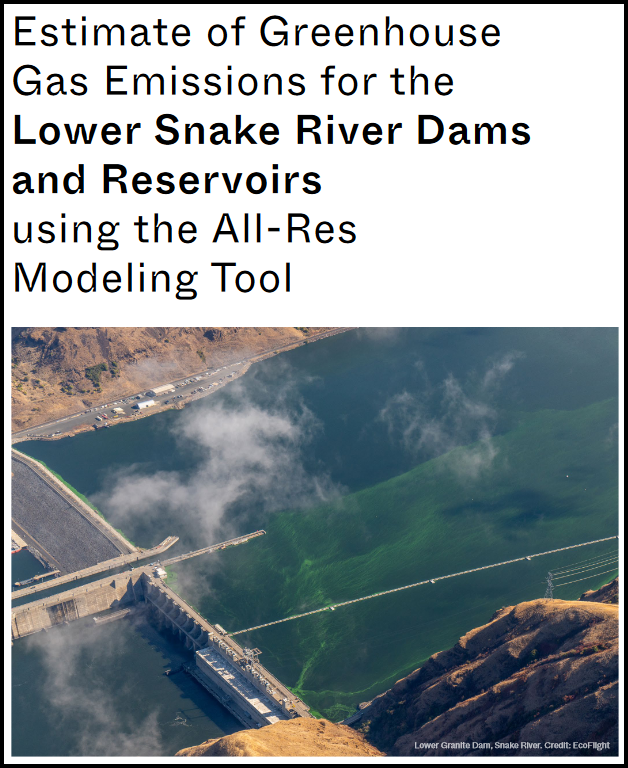March 18, 2024
For Immediate Release
Contact: patagoniapress@patagonia.com
or
Gary Wockner, Tell The Dam Truth, 970-218-8310, info@tellthedamtruth.com
New Report Finds Lower Snake River Dams Create Methane Emissions, Not Clean Energy
Report Reveals Snake River Dams Annually Spew 1.8M Metric Tons of Carbon Emissions
Ventura, Calif: — New science on the four Lower Snake River dams is in and it disproves claims that hydropower is clean energy.
A new report finds these dams are not a source of green, zero-carbon energy, but rather a major source of the heat-trapping greenhouse gases causing the climate crisis. Compounding the problem, dams submerge and destroy natural carbon sinks that once grew under their reservoirs.
For decades, politicians and various industry leaders have defended damming rivers by pointing to the climate benefits of allegedly clean hydropower. The new report, titled “Estimate of Greenhouse Gas Emissions for the Lower Snake River Dams and Reservoirs using the All-Res Modeling Tool,” estimates the lifecycle greenhouse gas emissions, including methane, from the Lower Snake River dams, reservoirs and their hydropower systems. The report finds the four dams in Washington are responsible for emitting approximately 1,800,000 metric tons of carbon dioxide equivalent per year—nearly 10,000 railcars’ worth of coal burned.
“Contrary to popular belief, hydropower is not a carbon-neutral source of energy,” said Mark Easter, chief scientist for Tell The Dam Truth and a former senior research associate at Colorado State University’s Natural Resource Ecology Laboratory. “The concept of how methane gets produced by dams and reservoirs is not widely understood. And that’s the source of the problem here—the Lower Snake River dams and reservoirs are giant methane factories, and the science proves it.”
Easter and Tell The Dam Truth, a nonprofit with a goal of exposing dams as climate catastrophes, used the All-Res Modeling Tool, which estimates emissions using a lifecycle analysis framework and includes the known greenhouse gas emissions emitted by dams and reservoirs through their entire lifespan. Patagonia’s Holdfast Collective provided financial support to develop the All-Res tool, and Patagonia has provided $1.5 million in grant funding to more than 15 grassroots environmental nonprofits working on Snake River dam removal since 2000. Patagonia has also made a feature-length film about dams, DamNation, and is currently running a campaign to raise awareness and spark action on these issues.
Dams and the reservoirs behind them emit methane and other potent greenhouse gases when artificially trapped organic material decomposes underwater. The research shows the dams on the Lower Snake River produce the equivalent carbon emissions of burning 2 billion pounds of coal annually. Dams also destroy carbon-capturing habitats, ruin life-sustaining fisheries and starve coastal communities of the sand and rocks critical to defending against rising seas.
Patagonia, along with a coalition of policymakers, tribal leaders, wild river advocates, anglers and others, is advocating a proven solution: Removing the Lower Snake River dams. In December, the Biden administration announced a 10-year partnership with Tribes and states to restore wild salmon and expand clean-energy production in the Columbia River Basin in the Pacific Northwest.
“Only by removing these dams, can we begin to restore the magnificent Columbia and Snake River watershed, save numerous species from extinction, honor treaty rights and build climate resiliency,” said Patagonia CEO Ryan Gellert. “We applaud investments in true clean-energy solutions and programs that recover wild, self-sustaining fish populations that Tribes and other local communities depend on. We’re hopeful Congress will finally recognize that hydropower harms ecosystems and the climate, and that they must authorize removing the dams to free the Snake River.”
This press release is posted here.
###
